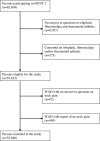Symptom profile of persons self-reporting whiplash: a Norwegian population-based study (HUNT 2)
- PMID: 19669172
- PMCID: PMC2899529
- DOI: 10.1007/s00586-009-1106-6
Symptom profile of persons self-reporting whiplash: a Norwegian population-based study (HUNT 2)
Abstract
The aetiology of chronic whiplash associated disorder (WAD) is unclear and the condition has been perceived both as a chronic pain disorder, based on the injury to the neck, and as a functional somatic disorder. Based on the hypothesis that chronic WAD should be perceived as a functional somatic syndrome, we compared the symptom profile of persons with chronic WAD with the profile of persons with a functional somatic disorder, and with the profile of persons with an organic pain disorder. A sample of 55,046 persons participating in a Norwegian population-based health study (HUNT 2) was divided into four study groups: chronic WAD, fibromyalgia, rheumatoid arthritis, and controls (none of these disorders). Symptoms were categorized as pain and stiffness, cardiopulmonary and gastrointestinal symptoms, and mental disorders. Odds ratios (ORs) with 95% confidence intervals (CIs) from logistic regression were used to compare the prevalence of symptoms among the groups. The chronic WAD group had a significantly higher prevalence of symptoms from all body parts, across organ systems and also mental symptoms, compared to the control group. The fibromyalgia group had an even higher prevalence of all symptoms, while the rheumatoid arthritis group showed an increase in the prevalence of particularly pain and stiffness symptoms and also a minor increase in the prevalence of other symptoms compared to the control group. We conclude that this study provide evidence in favour of the hypothesis that chronic WAD should be perceived as a functional somatic syndrome. Persons with chronic WAD had a symptom profile more similar to people with a functional somatic disorder than an organic pain disorder, consisting of a wide array of symptoms, not only predominantly pain symptoms.
Figures
Similar articles
-
Somatic symptoms beyond those generally associated with a whiplash injury are increased in self-reported chronic whiplash. A population-based cross sectional study: the Hordaland Health Study (HUSK).BMC Psychiatry. 2012 Aug 31;12:129. doi: 10.1186/1471-244X-12-129. BMC Psychiatry. 2012. PMID: 22935146 Free PMC article.
-
What characterizes individuals developing chronic whiplash?: The Nord-Trøndelag Health Study (HUNT).J Psychosom Res. 2013 May;74(5):393-400. doi: 10.1016/j.jpsychores.2013.02.004. Epub 2013 Mar 13. J Psychosom Res. 2013. PMID: 23597326
-
Is temporomandibular pain in chronic whiplash-associated disorders part of a more widespread pain syndrome?Clin J Pain. 2005 Jul-Aug;21(4):353-7. doi: 10.1097/01.ajp.0000125264.40304.8c. Clin J Pain. 2005. PMID: 15951654
-
Course and prognostic factors for neck pain in whiplash-associated disorders (WAD): results of the Bone and Joint Decade 2000-2010 Task Force on Neck Pain and Its Associated Disorders.Spine (Phila Pa 1976). 2008 Feb 15;33(4 Suppl):S83-92. doi: 10.1097/BRS.0b013e3181643eb8. Spine (Phila Pa 1976). 2008. PMID: 18204405 Review.
-
The burden and determinants of neck pain in whiplash-associated disorders after traffic collisions: results of the Bone and Joint Decade 2000-2010 Task Force on Neck Pain and Its Associated Disorders.Spine (Phila Pa 1976). 2008 Feb 15;33(4 Suppl):S52-9. doi: 10.1097/BRS.0b013e3181643ece. Spine (Phila Pa 1976). 2008. PMID: 18204401 Review.
Cited by
-
Headache and musculoskeletal complaints among subjects with self reported whiplash injury: the HUNT-2 study.BMC Musculoskelet Disord. 2011 Jun 8;12:129. doi: 10.1186/1471-2474-12-129. BMC Musculoskelet Disord. 2011. PMID: 21651816 Free PMC article.
-
Initial healthcare and coping preferences are associated with outcome 1 year after whiplash trauma: a multicentre 1-year follow-up study.BMJ Open. 2015 Mar 20;5(3):e007239. doi: 10.1136/bmjopen-2014-007239. BMJ Open. 2015. PMID: 25795697 Free PMC article.
-
Whiplash Syndrome Reloaded: Digital Echoes of Whiplash Syndrome in the European Internet Search Engine Context.JMIR Public Health Surveill. 2017 Mar 27;3(1):e15. doi: 10.2196/publichealth.7054. JMIR Public Health Surveill. 2017. PMID: 28347974 Free PMC article.
-
Somatic symptoms beyond those generally associated with a whiplash injury are increased in self-reported chronic whiplash. A population-based cross sectional study: the Hordaland Health Study (HUSK).BMC Psychiatry. 2012 Aug 31;12:129. doi: 10.1186/1471-244X-12-129. BMC Psychiatry. 2012. PMID: 22935146 Free PMC article.
-
Factors related to non-recovery from whiplash. The Nord-Trøndelag Health Study (HUNT).Int J Behav Med. 2014 Jun;21(3):430-8. doi: 10.1007/s12529-013-9338-6. Int J Behav Med. 2014. PMID: 24048964
References
-
- Barsky AJ, Borus JF. Functional somatic syndromes. Ann Intern Med. 1999;130:910–921. - PubMed
Publication types
MeSH terms
LinkOut - more resources
Full Text Sources
Medical


